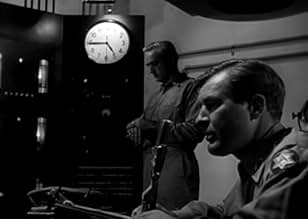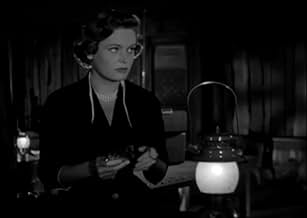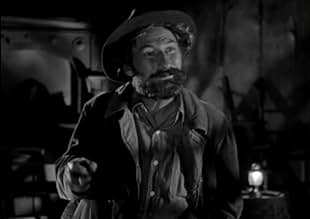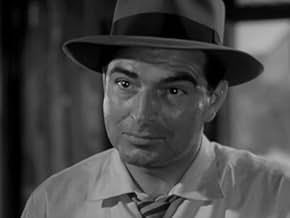IMDb रेटिंग
6.8/10
2.2 हज़ार
आपकी रेटिंग
अपनी भाषा में प्लॉट जोड़ेंThree hardened criminals take hostages and hide in a Nevada mining ghost town, knowing that an atom bomb is scheduled to be tested there the next morning.Three hardened criminals take hostages and hide in a Nevada mining ghost town, knowing that an atom bomb is scheduled to be tested there the next morning.Three hardened criminals take hostages and hide in a Nevada mining ghost town, knowing that an atom bomb is scheduled to be tested there the next morning.
Frank DeKova
- Dummy
- (as Frank de Kova)
Fred Aldrich
- Hunter Driver
- (बिना क्रेडिट के)
Benny Burt
- Hunter
- (बिना क्रेडिट के)
John Cliff
- Gas Station Attendant
- (बिना क्रेडिट के)
Dick Crockett
- Air Force Helicopter Pilot
- (बिना क्रेडिट के)
John Diggs
- Colonel at Control Station
- (बिना क्रेडिट के)
William Forrest
- Colonel Wright
- (बिना क्रेडिट के)
Fred Graham
- A.F. Captain in Helicopter
- (बिना क्रेडिट के)
Karen Hale
- Nurse
- (बिना क्रेडिट के)
Clark Howat
- Lieutenant at Control Station
- (बिना क्रेडिट के)
फ़ीचर्ड समीक्षाएं
Small gem of a movie filled with faces you know. Glad I stumbled upon it today.
Split Second is directed by Dick Powell and written by William Bowers, Irving Wallace and Chester Erskine. It stars Stephen McNally, Alexis Smith, Jan Sterling, Keith Andes, Arthur Hunnicutt, Richard Egan, Paul Kelly, Robert Paige and Frank DeKova. Music is by Roy Webb and cinematography by Nicholas Musuraca.
Escaped convict Sam Hurley (McNally) is on the run with his wounded pal Bart Moore (Kelly) and henchman accomplice Dummy (DeKova). Carjacking two lots of hostages, Hurley takes them to a ghost town on an Atom Bomb test sight figuring it's the perfect place to hole up. But with Moore in need of medical help, the test bomb set to go off in the morning and tempers frayed within the group, something is going to have to give...
A taut and sweaty noir, Split Second taps into the 50s fear of the bomb and explodes the character dynamics Petrified Forest style. The premise is simple, once the character introductions are out the way, we wind our way to a bleak ghost town and stay in the company of a disparate group of people for the remainder of the film. As the clock ticks down, with the bomb set to be detonated on the town at 06.00, the various characters introduce their respective traits into the story. The tension mounts and the over-spills are often nervy, sleazy and poignant.
The makers don't soft soap the situations, but they do dangle shards of sympathy. As is the case with Hurley, who is a cold blooded killer, we know and witness this, but his back story is that of a war hero, he also has a deep affection for his injured older pal, somewhere along the line a good man lost his balance. Dottie Vale (Sterling) is a dancer, street wise and aware of how to play the situation, but sadness resides behind her waspish tongue. Kay Garven (Smith) is a lost cause, she will do anything and trample on anyone to save herself. One of the best sequences in the film finds Garven throwing herself at Hurley, the rest goes on behind closed doors, but we know what happens and it adds spice to what follows in the final third.
Not all of the characters work for dramatic impact, such as Hunnicutt's talkative miner who wanders in to the plot at the mid-point (it's amazing how easy everyone finds it to get into this supposedly secure military site!), but the dynamics work wonderfully well. Weaklings, heroes in waiting, the forlorn, the foolish or the borderline psychotic, they all make for a potent and spicy psychological stew. The suspense angle of the impending bomb detonation is water tight, as is the ebbing away of Bart Moore, directer Powell never resorts to cheap tactics or clichés to keep the noose tight, and we are constantly wondering just who, if anyone? Will survive the ordeal.
Once daylight disappears and we leave the scorching Mojave vistas behind, night time envelopes the ghost town and ace cinematographer Musuraca brings his atmospheric magic. Webb scores it with dramatic verve and the RKO effects team (headed by Harold Wellman) do sterling work to pull it all together without cheap and tacky baggage. Powell gets great performances out of McNally, Kelly, Sterling, Egan and Smith, while his ability to not let the logic holes dominate the narrative belies the fact that this was his first directing assignment.
From the ominous opening shot of two men fleeing over sun-baked mud flats, to the thrilling and darkly tinged denouement, Split Second is a coiled spring waiting to explode. 8/10
Escaped convict Sam Hurley (McNally) is on the run with his wounded pal Bart Moore (Kelly) and henchman accomplice Dummy (DeKova). Carjacking two lots of hostages, Hurley takes them to a ghost town on an Atom Bomb test sight figuring it's the perfect place to hole up. But with Moore in need of medical help, the test bomb set to go off in the morning and tempers frayed within the group, something is going to have to give...
A taut and sweaty noir, Split Second taps into the 50s fear of the bomb and explodes the character dynamics Petrified Forest style. The premise is simple, once the character introductions are out the way, we wind our way to a bleak ghost town and stay in the company of a disparate group of people for the remainder of the film. As the clock ticks down, with the bomb set to be detonated on the town at 06.00, the various characters introduce their respective traits into the story. The tension mounts and the over-spills are often nervy, sleazy and poignant.
The makers don't soft soap the situations, but they do dangle shards of sympathy. As is the case with Hurley, who is a cold blooded killer, we know and witness this, but his back story is that of a war hero, he also has a deep affection for his injured older pal, somewhere along the line a good man lost his balance. Dottie Vale (Sterling) is a dancer, street wise and aware of how to play the situation, but sadness resides behind her waspish tongue. Kay Garven (Smith) is a lost cause, she will do anything and trample on anyone to save herself. One of the best sequences in the film finds Garven throwing herself at Hurley, the rest goes on behind closed doors, but we know what happens and it adds spice to what follows in the final third.
Not all of the characters work for dramatic impact, such as Hunnicutt's talkative miner who wanders in to the plot at the mid-point (it's amazing how easy everyone finds it to get into this supposedly secure military site!), but the dynamics work wonderfully well. Weaklings, heroes in waiting, the forlorn, the foolish or the borderline psychotic, they all make for a potent and spicy psychological stew. The suspense angle of the impending bomb detonation is water tight, as is the ebbing away of Bart Moore, directer Powell never resorts to cheap tactics or clichés to keep the noose tight, and we are constantly wondering just who, if anyone? Will survive the ordeal.
Once daylight disappears and we leave the scorching Mojave vistas behind, night time envelopes the ghost town and ace cinematographer Musuraca brings his atmospheric magic. Webb scores it with dramatic verve and the RKO effects team (headed by Harold Wellman) do sterling work to pull it all together without cheap and tacky baggage. Powell gets great performances out of McNally, Kelly, Sterling, Egan and Smith, while his ability to not let the logic holes dominate the narrative belies the fact that this was his first directing assignment.
From the ominous opening shot of two men fleeing over sun-baked mud flats, to the thrilling and darkly tinged denouement, Split Second is a coiled spring waiting to explode. 8/10
My understanding of this motion picture is much different. My family owned the gas station and inn that appears in the picture. I have many memories of director Powell flying around in a rather unusual aircraft for the time, a helicopter. Being very young, I didn't have much interaction with the adults as they wanted to imbibe after the shootings for the day but I do recall having to be silent and not play in the front of the business. This is truly a unique story line for the early '50s. The cold war was in full swing so any movie about this subject captured audience attention. I have since purchased video tapes for members of my family. Excelent example of the A-Bomb era genre. Others: The Day The Earth Stood Still, Godzilla.
Stephen McNally, what a mean man. Boy, could he play the bad guy >and almost make you love him. Not to condone his actions in the >flick, but to say that he acted with bravado. He had the knack >for being mean. In this film, he needs to be the "man" to stay >alive, but fate has a way of making humans small. This story is >so tight and well done, that this is a keeper. Next time it's >run turn on the VCR and hit record. It's the kind of flick that >stands up well today by fitting in with the violent control >people will always display when they are criminals on the run. >Beautiful Alexis Smith and sultry Jan Sterling bring out the >animal instincts in the men of the cast. Their looks are just as >persuasive as their acting abilities. This is a "B" movie that >rates an "A+" for showing that it could be done with the right >chemistry of the cast, director and producer. I love this type >of flick!
The genre of film-noir can be divided into three eras - generally speaking: the classic era (1940-1945), the postwar era (1945-1953) and the Cold War era (1953-1958-60?). Film-noir was always a genre about fear, moral complexity and desperation. When the WWII film-noir exuded postwar disillusions; the concrete war was over but it was still going on on social level: in our minds and in the society. What genre would fit more perfectly to the ages of paranoia and fear than the genre of them, film-noir. To my mind Split Second is the first Cold War film-noir - a statement which one could argue about because in the same year 1953 Samuel Fuller made a film-noir about paranoia and the fear of communism Pickup on South Street (1953).
Dick Powell was the star of the Hollywood musicals in 1930's. In 1940's he tried to change his image from a singing dancer to the new bad boy of Hollywood. In 1944 Edward Dmytryk directed Murder, My Sweet based on a novel by Raymond Chandler and casted Dick Powell to play Philip Marlowe - the greatest private eye of film-noir, but the performance by Powell is often left in the shadows of Humphrey Bogart's Philip Marlowe interpretation in The Big Sleep (1946). After the war Dick Powell had some experience from film-noir and he chose to try directing as well. Split Second was his debut of the six films he directed and I think he succeed quite well in it.
1950's was the age when the government of the United States made a lot of nuclear weapon experiments: in the deserts of US and in the famous Bikini island. This offered a chance to make a thriller around these kind of events and Split Second represents the attempt of transforming film-noir from its usual big city milieus to a deserted town in Nevada under the fear of the war. Three men have just escaped from prison, unaware of the nuclear experiments of the government. Soon the group of three takes a few hostages in result of getting a doctor because one of the escapees is injured. As time goes on in the deserted town the hostages start to lose their morality and the time before the explosion is running out.
The aesthetics of film-noir were often related to big cities like New York or Los Angeles and exotic milieus were always part of the genre but usually they meant bars in Chinatown, motels of Arabia or the cold streets of Shanghai. In 1950's many tried to transform film-noir to new milieus: to snowy conditions (On Dangerous Ground), to the narrow halls of a train (The Narrow Margin) and to the back seats of a car (The Hitch-Hiker). To me Split Second represents the attempt of transforming film-noir to deserted towns, which The Hitch-Hiker (1953) did as well, but Split Second also tried to bring film-noir to the Atomic Age.
There's no question whether this is a high quality noir or a B-class film. The latter can be seen in its conventional direction, low budget and it has got a great number of unknown actors. But the way I see it Split Second is alongside with all the b-class Mitchum films one of the bests. It's a great example of Cold War films and how the Atomic Age affected cinema. It's an entertaining thriller but also a fine survey of the disappearance of morality.
Dick Powell was the star of the Hollywood musicals in 1930's. In 1940's he tried to change his image from a singing dancer to the new bad boy of Hollywood. In 1944 Edward Dmytryk directed Murder, My Sweet based on a novel by Raymond Chandler and casted Dick Powell to play Philip Marlowe - the greatest private eye of film-noir, but the performance by Powell is often left in the shadows of Humphrey Bogart's Philip Marlowe interpretation in The Big Sleep (1946). After the war Dick Powell had some experience from film-noir and he chose to try directing as well. Split Second was his debut of the six films he directed and I think he succeed quite well in it.
1950's was the age when the government of the United States made a lot of nuclear weapon experiments: in the deserts of US and in the famous Bikini island. This offered a chance to make a thriller around these kind of events and Split Second represents the attempt of transforming film-noir from its usual big city milieus to a deserted town in Nevada under the fear of the war. Three men have just escaped from prison, unaware of the nuclear experiments of the government. Soon the group of three takes a few hostages in result of getting a doctor because one of the escapees is injured. As time goes on in the deserted town the hostages start to lose their morality and the time before the explosion is running out.
The aesthetics of film-noir were often related to big cities like New York or Los Angeles and exotic milieus were always part of the genre but usually they meant bars in Chinatown, motels of Arabia or the cold streets of Shanghai. In 1950's many tried to transform film-noir to new milieus: to snowy conditions (On Dangerous Ground), to the narrow halls of a train (The Narrow Margin) and to the back seats of a car (The Hitch-Hiker). To me Split Second represents the attempt of transforming film-noir to deserted towns, which The Hitch-Hiker (1953) did as well, but Split Second also tried to bring film-noir to the Atomic Age.
There's no question whether this is a high quality noir or a B-class film. The latter can be seen in its conventional direction, low budget and it has got a great number of unknown actors. But the way I see it Split Second is alongside with all the b-class Mitchum films one of the bests. It's a great example of Cold War films and how the Atomic Age affected cinema. It's an entertaining thriller but also a fine survey of the disappearance of morality.
क्या आपको पता है
- ट्रिवियाThe escaped convict Bart Moore is played by Paul Kelly, who himself spent 25 months during the late 1920s in California's San Quentin State Prison. He was convicted of manslaughter for the beating death of actor Ray Raymond, the first husband of actress Dorothy Mackaye, who was having an affair with Kelly and would later marry him. Kelly's next film was Duffy of San Quentin (1954), where he plays the title role - the warden of the prison where he himself did time.
- गूफ़Considering the level of security around the test site, including the number of roadblocks set up to keep people away, it should have been impossible for Dr. Garven to drive into the ghost town seemingly unimpeded.
- भाव
Larry Fleming: [referring to Dottie's mother] Six husbands, and you're still working on your first.
Dorothy 'Dottie' Vail: Mother used up all the men we knew.
- कनेक्शनFeatured in Noir Alley: Split Second (2017)
टॉप पसंद
रेटिंग देने के लिए साइन-इन करें और वैयक्तिकृत सुझावों के लिए वॉचलिस्ट करें
- How long is Split Second?Alexa द्वारा संचालित
विवरण
- चलने की अवधि1 घंटा 25 मिनट
- रंग
- पक्ष अनुपात
- 1.37 : 1
इस पेज में योगदान दें
किसी बदलाव का सुझाव दें या अनुपलब्ध कॉन्टेंट जोड़ें





































